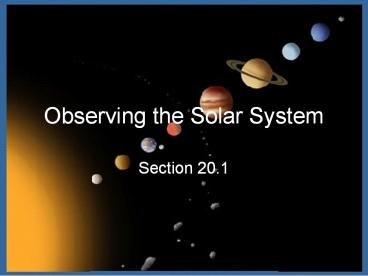Observing the Solar System - PowerPoint PPT Presentation
Title:
Observing the Solar System
Description:
Observing the Solar System Section 20.1 Early Observations Greek Observations Saw star patterns in the sky travel together (Constellations) Early Observations Some ... – PowerPoint PPT presentation
Number of Views:184
Avg rating:3.0/5.0
Title: Observing the Solar System
1
Observing the Solar System
- Section 20.1
2
Early Observations
- Greek Observations
- Saw star patterns in the sky travel together
- (Constellations)
3
(No Transcript)
4
Early Observations
- Some stars seemed to wander (planets)
- They were later named by the Romans
- (Mercury, Venus, Mars, Jupiter, Saturn)
5
Early Observations
- Most Greek astronomers believed that Earth was in
the center of a celestial sphere. (geocentric
system)
6
Early Observations
- Claudius Ptolemy
- Earth in center
- Planets move on small
- circle that move on
- bigger circles
- Widely accepted for
- 1500 years
7
Early Observations
- Nicholas Copernicus
- Believed in a sun centered system (Heliocentric)
- Said the planets moved around the sun in circles
in 1543
Mikolaj Kopernik
8
Early Observations
- Nicholas Copernicus
- Was banned by the Catholic church
- Galileo
- Used the telescope to support him (Venus phases,
Jupiters moons) - Was placed under house arrest
Mikolaj Kopernik
Galileo
9
Early Observations
- Tycho Brahe
- Made accurate observation for over 20 years
10
Early Observations
- Johannes Kepler
- Analyzed Brahes observations and found that the
path of the orbits were ellipses - Keplers 1st Law
11
Early Observations
- Johannes Kepler
- He found that the speed of orbiting planets is
constantly changing - Keplers 2nd Law
12
Early Observations
- Johannes Kepler
- When he compared planets, he found a relationship
between how far from the sun they were and the
time to make one orbit - Keplers 3rd Law
13
Early Observations
- Today we know of 8 planets (MVEMJSUN) their
moons, and smaller objects that revolve around
the sun
14
What about Pluto?
- According to the new definition, a full-fledged
planet is an object that orbits the sun and is
large enough to have become round due to the
force of its own gravity. In addition, a planet
has to dominate the neighborhood around its
orbit. - Pluto does not dominate its neighborhood
- Charon is half it size
- It does not sweep up its neighborhood, there
is - much debris in its orbit































